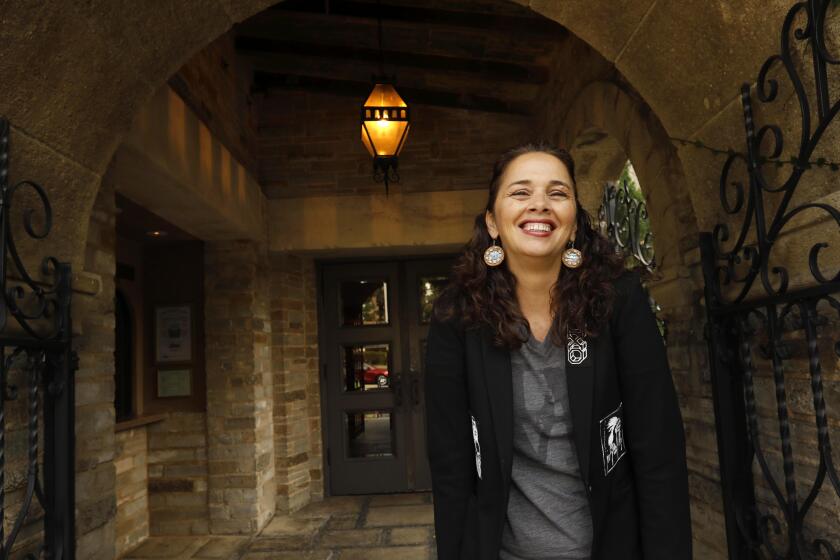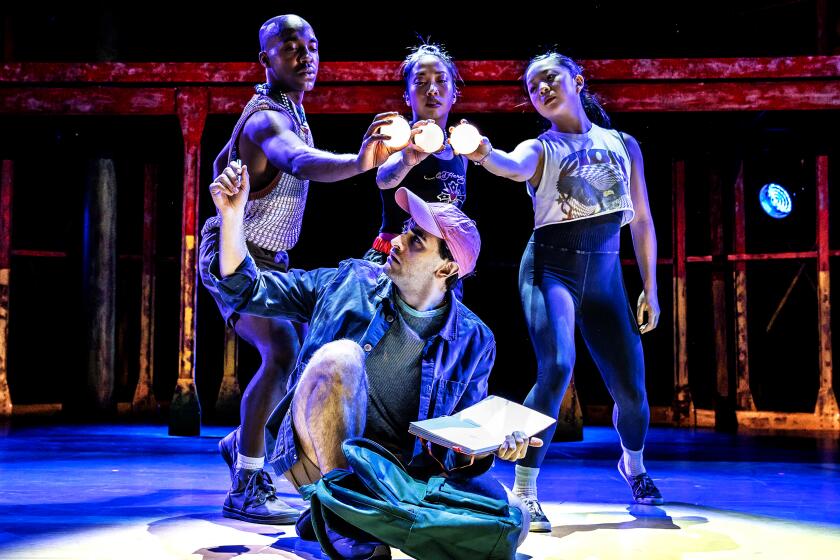Joseph Young, 87;his murals, sculptures adorn the Southland
Joseph Young, an artist who created dozens of sculptures, glass mosaic murals and cast-concrete bas-reliefs in Los Angeles and is best known for his controversial Triforium public artwork at the Civic Center, has died. He was 87.
A resident of West Hollywood since 1952, Young died Thursday of pneumonia at Brotman Medical Center in Culver City, his widow, Millicent Young, said Saturday. He had overcome lung cancer several years ago, she said.
Young’s last major commission was the dramatic black granite Los Angeles Holocaust Monument at Pan Pacific Park in the Miracle Mile district, dedicated in 1992. His stained-glass windows and mosaic murals grace temples and churches across the Southland.
Most of his works were made and installed locally, including murals at the Los Angeles County Hall of Records, the Los Angeles Police Department’s headquarters at Parker Center, Hollenbeck police station, the UCLA math sciences building and many other schools and libraries. He also designed mosaics in the west apse of the Basilica of the National Shrine of the Immaculate Conception in Washington, D.C.
But Young is best known for the Triforium, a three-pronged, six-story, 60-ton concrete sculpture decorated with colorful Italian glass, outfitted with 1,494 light bulbs pulsating to its built-in music system and set in a reflecting pool of water.
He called it a poly-phonoptic kinetic tower, designed to reflect the unfinished, kaleidoscopic nature of the city. But since its unveiling in 1975 at Temple and Main streets, critics have called it the “Trifoolery,” “the Psychedelic Nickelodeon” and “Three Wishbones in Search of a Turkey.”
The $925,000 structure had problems from the beginning, with the sound system shorting out, then not playing in sync with the lights, followed by water leaks into the subterranean mall below it. In a few years it became a dull, silent hulk.
“I get very upset when I see it,” Young said in a 1996 interview with The Times. “It’s like a baby who was never born.”
The structure was restored last December, and its light and music show resumed.
“At the time it was built, it was quite the controversy,” Councilwoman Jan Perry, who helped lead the preservation efforts, said Saturday. “He, as a civic artist, was probably way ahead of his time, in the sense that he used some very interesting materials, and to incorporate music in the public display is really quite unusual.”
Joseph Louis Young was born Nov. 27, 1919, in Pittsburgh and grew up in the nearby steel mill town of Aliquippa, Pa. His father, a Ukrainian immigrant, was a merchant who ran a variety store. His mother, a Romanian immigrant, studied design and millinery at what is now Carnegie Mellon University in Pittsburgh.
Young studied art, literature and journalism at Westminster College in New Wilmington, Pa. After earning a bachelor’s degree in 1941, he moved to New York City to work at United Press.
Drafted into the Army Air Forces, he wrote articles and drew cartoons for military publications. After World War II ended, Young took art classes at various schools in New York, the Cranbrook Academy of Art in Michigan and the Boston Museum of Fine Arts.
On a visit home to Pittsburgh he met pianist Millicent Goldstein at a concert and married her in 1949. Two years later they both won fellowships to study at the American Academy in Rome, she in music and he in fresco and stained-glass. While in Italy, Young discovered the Byzantine mosaics in Ravenna and Venice and settled on what became his favorite medium.
In 1952 the couple moved to Los Angeles after earning fellowships from the Huntington Hartford Foundation.
Three years later Young won a commission to design a mosaic mural for the lobby of Parker Center on Los Angeles Street. The 6-foot by 36-foot depiction of the panoramic history of Los Angeles was the first of his works in public spaces. A review in American Artist described it as “Six tons of steel, copper, aluminum and glass, fused into a monolithic mosaic panel of beauty and permanence that seems to float on air.”
How permanent it is remains to be seen. The LAPD is vacating Parker Center for new headquarters a few blocks away, and Young’s family is not certain whether the mosaic will follow.
“The irony is that in later years, the locations of many of his works are now themselves threatened with demolition,” said his daughter Cecily Young. “The artwork is timeless, but the building it was set into is not.”
However, the prospects are bright for Young’s mosaic-and-granite mural that since 1962 has adorned the north face of the Hall of Records on Temple Street.
“Topographical Map,” a large-scale, abstract view of L.A. County and its water resources, had fallen into decay in recent years, but renovations of the mural and its fountain are to be completed next month.
Besides his wife and daughter, Young is survived by another daughter, Leslie Young; and three grandchildren.
A funeral will be held at 3 p.m. Monday at Eden Memorial Park in Mission Hills, where he designed an 18-foot-tall mosaic bas-relief depicting the 12 tribes of ancient Israel.
Instead of flowers, his family suggests donations in his name to the Alzheimer’s Assn. of America, www.alz.org, or the Samuel Oschin Comprehensive Cancer Institute at Cedars-Sinai Medical Center, 8700 Beverly Blvd., Los Angeles, CA 90048.
--
More to Read
The biggest entertainment stories
Get our big stories about Hollywood, film, television, music, arts, culture and more right in your inbox as soon as they publish.
You may occasionally receive promotional content from the Los Angeles Times.





